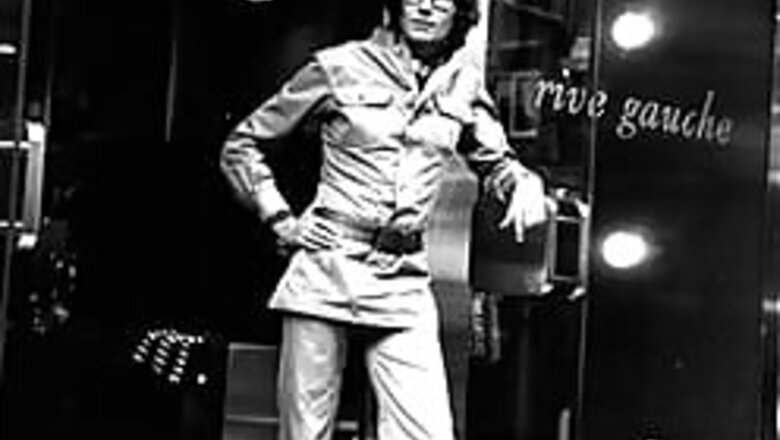
views
Paris: Legendary designer Yves Saint Laurent, who reworked the rules of fashion by putting women into elegant pantsuits that came to define how modern women dressed, died on Sunday evening. He was 71.
Pierre Berge, Saint Laurent's business partner for four decades, said he had died at his Paris residence following prolonged illness.
A towering figure of 20th century fashion, Saint Laurent was widely considered the last of a generation that included Christian Dior and Coco Chanel and made Paris the fashion capital of the world, with the Rive Gauche, or Left Bank, as its elegant headquarters.
In the fast-changing world of haute couture, Saint Laurent was hailed as the most influential and enduring designer of his time. From the first YSL tuxedo and his trim pantsuits to see-through blouses, safari jackets and glamorous gowns, Saint Laurent created instant classics that remain stylish decades later.
Berge praised Saint Laurent as the man who marked “the second half of the 20th century” in fashion.
“Chanel gave women freedom” in the first half, and SaintLaurent “gave them power,” he said on France-Info radio. Saint Laurent was a “true creator,” going beyond the aesthetic to make a social statement, Berge said.
“In this sense he was a libertarian, an anarchist and he threw bombs at the legs of society. That's how he transformed society and that's how he transformed women,” he said.
When Saint Laurent announced his retirement in 2002 at age 65 and the closure of the Paris-based haute couture house he had founded 40 years earlier, it was mourned in the fashion world as the end of an era. His ready-to-wear label, Rive Gauche, which was sold to Gucci in 1999, still has boutiques around the world.
In October 2006, Saint Laurent slipped and fell outside a Paris restaurant during Fashion Week, suffering slight scratches but reminding fans of the perennially fragile designer's advancing age.
Saint Laurent was born on August 1, 1936, in Oran, Algeria, where his father worked as a shipping executive. He first emerged as a promising designer at the age of 17, winning the first prize in a contest sponsored by the International Wool Secretariat for a cocktail dress design.
A year later in 1954, he enrolled at the Chambre Syndicale school of haute couture, but student life lasted only three months. He was introduced to Christian Dior, then regarded as the greatest creator of his day, and Dior was so impressed with Saint Laurent's talent that he hired him on the spot.
PAGE_BREAK
When Dior died suddenly in 1957, Saint Laurent was named head of the House of Dior at the age of 21. The next year, his first solo collection for Dior – the “trapeze” line – launched Saint Laurent's stardom. The trapeze dress, with its narrow shoulders and wide swinging skirt, was a hit, and a breath of fresh air after years of constructed clothing, tight waists and girdles.
In 1960, Saint Laurent was drafted into military service – an experience that shattered the delicate designer, who by the end of the year was given a medical discharge for nervous depression.
Bouts of depression marked his career. Berge, the designer's long-time business partner and former romantic partner, was quoted as saying that Saint Laurent was born with a nervous breakdown.
The resurrection of fashion
Saint Laurent returned to the spotlight in 1962, opening his own haute couture fashion house with Berge. The pair later started a chain of Rive Gauche ready-to-wear boutiques.
Life magazine hailed his first line under his own label as “the best collection of suits since Chanel”.
Berge has said that Saint Laurent's gift to fashion was that he empowered women after Chanel had freed them.
Nowhere was Saint Laurent's gift more evident than the valedictory fashion show that marked his retirement in January 2002.
Forty years of fashion were paraded in a 300-piece retrospective that blurred the boundaries of time, mixing his creations of yesterday and today in one stunning tribute to the endurance of Saint Laurent's style. He also designed costumes for theatre and film.
There was the simple navy blue pea coat over white pants, which the designer first showed in 1962 when he opened his couture house and kept as one of his hallmarks.
His “smoking,” or tuxedo jacket, of 1966 remade the tux as a high fashion statement for both sexes. It remained the designer's trademark item and was updated yearly until he retired.
Also from the 60s came Beatnik chic – a black leather jacket and knit turtleneck with high boots – and sleek pantsuits that underlined Saint Laurent's statement on equality of the sexes. He showed that women could wear “men's clothes,” which when tailored to the female form became an emblem of elegant femininity.
PAGE_BREAK
“More than any other designer since Chanel, YSL represented Paris as the style leader,” The Independent of London wrote in an editorial after Saint Laurent's retirement. “By putting a woman in a man's tuxedo, he changed fashion forever, in a style that never dated”.
In his own words, Saint Laurent said he felt “fashion was not only supposed to make women beautiful, but to reassure them, to give them confidence, to allow them to come to terms with themselves.”
Some of his revolutionary style was met with resistance. There are famous stories of women wearing Saint Laurent pantsuits who were turned away from hotels and restaurants in London and New York.
One scandal centred on the designer himself, when he posed nude and floppy-haired for a photographer in 1971, wearing only his trademark thick black glasses, to promote his perfume.
Saint Laurent's rising star was eternalised in 1983, when the Metropolitan Museum of Art devoted a show to his work, the first ever to a living designer.
Subsequent shows at the Hermitage in St. Petersburg and in Beijing made him a French national treasure, and he was awarded the Legion d'Honneur in 1985.
When France basked in the glory of its 1998 World Cup soccer final, it was Saint Laurent who took centre field pre-kick off with an on-field retrospective at the Stade de France.
In 1999, Saint Laurent sold the rights of his label to Gucci Group NV, ceding control of his Rive Gauche collection, fragrances, cosmetics and accessories for US$70 million cash and royalties.
Industry insiders cited friction between Saint Laurent and Gucci's creative director, Tom Ford, as a likely factor in the fashion guru's decision to retire three years later. Ford stepped down in 2003.
When he bowed out of fashion in 2002, Saint Laurent spoke of his battles with depression, drugs and loneliness, though he gave no indication that those problems were directly tied to his decision to stop working.
“I've known fear and terrible solitude,” he said. “Tranquilisers and drugs, those phony friends. The prison of depression and hospitals. I've emerged from all this, dazzled but sober.”



















Comments
0 comment